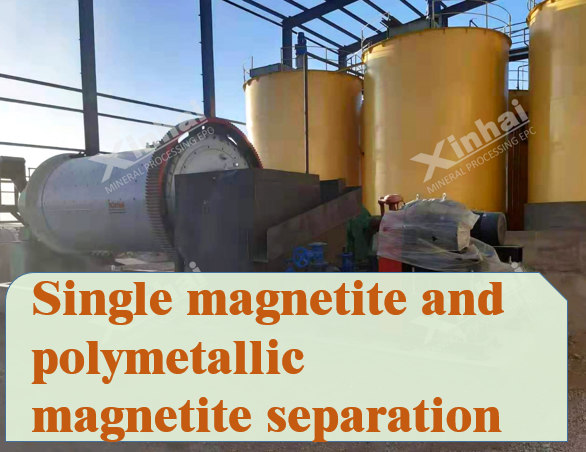Single magnetite and polymetallic magnetite separation
2024-09-29 Xinhai (1678)
2024-09-29 Xinhai (1678)
If you have any questions, please contact us through the following ways, we will give you more and better assistance!

Magnetite is mostly a granular aggregate with strong magnetism and wide distribution. According to the different types of iron-containing minerals, magnetite ores can be divided into single magnetite and mixed ores.
Generally, single magnetite ores are often separated by weak magnetic separation, while polymetallic magnetite ores and mixed ores are often separated by a combined process consisting of multiple separation methods, including magnetic separation, flotation, gravity separation, magnetization roasting magnetic separation, reduction roasting magnetic separation, etc.
Most of the iron minerals in single magnetite ores are magnetites. Since single magnetite ores have simple composition, strong magnetism, and are easy to grind and separate, weak magnetic separation methods are often used for separation.
◆ When the grinding particle size is greater than 0.2mm, most iron ore magnetic separation plants often use a one-stage grinding-magnetic separation process;
◆ When the grinding particle size is less than 0.2mm, a two-stage grinding-magnetic separation process is used;
◆ If qualified tailings are separated in the coarse grinding stage, the magnetite magnetic separation plant should adopt a stage grinding-magnetic separation process;
◆ For arid and water-scarce areas, magnetite separation plants can consider using dry grinding-dry magnetic separation process;
◆ For depleted magnetite-rich or depleted magnetite ores, the gangue can generally be removed by dry magnetic separation process, and after obtaining blocky rich ore, the concentrate can be obtained by grinding-magnetic separation process.

Polymetallic magnetite gangue often contains silicate or carbonate minerals, and associated cobalt pyrite, chalcopyrite and apatite, etc., and generally adopts weak magnetic separation-flotation combined process, that is, weak magnetic separation process is used to recover iron, and then sulfide or apatite is recovered by flotation process.
Usually, the weak magnetic separation-flotation combined process of polymetallic magnetite can be divided into two processes: weak magnetic separation-flotation and flotation-weak magnetic separation. The difference lies in the different destinations of the intergrowth of magnetite and sulfide. For the weak magnetic separation-flotation process, the intergrowth mainly enters the iron concentrate; for the flotation-weak magnetic separation process, the intergrowth mainly enters the sulfide concentrate. Therefore, under the same grinding particle size, the process of first flotation and then magnetic separation can obtain iron concentrate with lower sulfide content and sulfide concentrate with higher recovery rate.